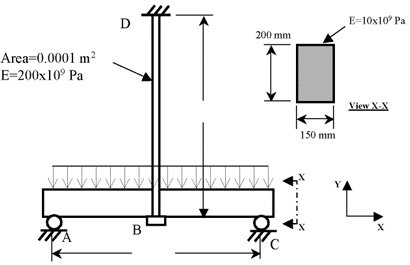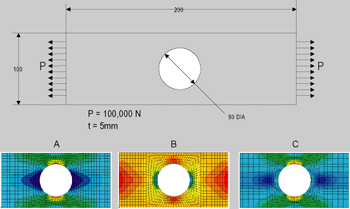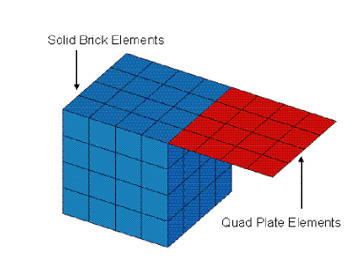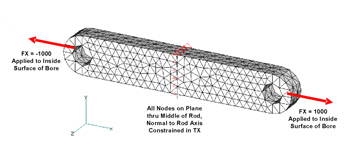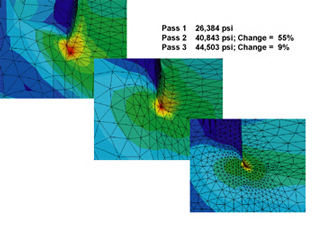Assess Your FEA Skills
As more companies embrace product simulation, it's critical todetermine your proficiency and your team's proficiency using analysistools.
Latest News
March 1, 2005
By Vince Adams
Most engineering organizations have embraced FEA at one level oranother. But a great disparity exists between the qualifications,skills, and knowledge required to actually use it successfully. Thedisconnect lies in the knowledge or misconceptions many users have onthe complexity of the technology. During the course of classes mycompany offers its clients, we break down the analysis process intothree steps:
- Ask the Question
- Answer the Question
- Interpret the Answer
|
Above: Solve for the reaction at A and D. Consider supports at A, C, and D as rigid. Below: Solve for deflection where load is applied and stress at transition betweendiameters; list assumptions. |
|
The advances in software speed and ease-of-use have made asking aquestion and getting an answer to that question extremely easy.However, asking the right question through the careful construction ofboundary conditions and material properties is not addressed orfacilitated by any interface improvements made over the years. Askingthe right question the right way is still a very engineering-specifictask. And interpreting the answer requires even more engineeringinsight.
Good engineers often perform bad FEA and, unfortunately, poorlyconstructed models—i.e., questions—and misinterpretation of resultsoften leads to erroneous design decisions. Engineers looking to expandthe use of FEA in the design process, especially as a predictive tool,need to take a lesson from the MCAD community and get a handle on theirskill levels. This sort of initiative is consistent with othercertification and licensing steps that many engineers undertake andshould be considered an important part of personal and professionalgrowth.
Preparing a Skill-Level Assessment
Skill-level assessment can be a difficult and controversial topic, soit’s imperative that skills assessment be conducted in a nonthreateningmanner. Most designers and engineers who are successful using moretraditional design techniques can be successful using FEA to augmenttheir other tools. However, engineers and managers need an honestunderstanding of where skill levels reside with respect to the needs ofthe company and its products. The assessment method should provideenough feedback on all three of the analysis tasks mentioned earlier sothat you have the data needed to structure a growth plan to fill inyour skill gaps.
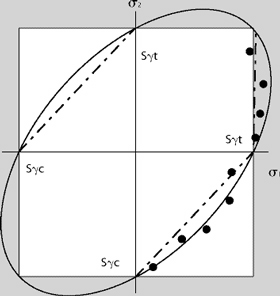
What do the ellipse, square, and dashed polygon represent? Why is this important?
Skill level assessment isn’t technically difficult, as there areseveral areas of expertise that are fundamental to the successful useof analysis in the design process. The difficulty lies in the potentialfor perceived threat. If a user is concerned that his job or reputationis on the line by cooperating with a skill assessment, he may put upserious resistance. Users must understand that the program is not atest but merely a tool to help them better understand their skills andneeds.
Elements ofSkill Assessment
As stated previously, any analysis, small- or large-scale, is comprisedof three tasks. Each task is critical to the validity of the problem.Therefore, a skills assessment program should evaluate all aspects ofthe analysis process—the software skills as well as the engineeringknowledge to effectively use the information.
| For the shown system, what is the maximum tensilestress at the hole? What stress quantities are represented by plots A,B, and C? Explain your responses. |
| What concerns do you have with the mesh as shown? How might you correct thisis in the software you use? |
The program that we have developed has four sections:
1. Basic Engineering Mechanics
2. Finite Element (FE) Knowledge
3. Hands-on Sample Problems
4. Portfolio Review
Basic Engineering Mechanics—Engineering mechanics is the cornerstone ofall predictive analysis and it is the first class we recommend whendeveloping a multicourse training program for clients. At a minimum, anengineering mechanics review should investigate:
- Material Properties
- Failure Theory
- Free-Body Diagrams
- Basic Hand
| Is this force-balanced system properly and sufficiently constrained? If not,how would you correct the model? |
| Why is the stress changing in these images? What is this process called? |
Finite Element Knowledge—A basic knowledge of FE terms, concepts,capabilities, and limitations is mandatory. Of importance is userfamiliarity with FE terminology and process, including a detailedreview of their understanding of:
- Mesh Quality and Validity
- Boundary Conditions
- Units
- Model Validation
Hands-On Sample Problems—Use and application of the tools of the tradeare extremely important to the success of an analyst, so a portion ofthe skills assessment should evaluate how a user handleshimself/herself on the “tube.” The review should include simple,easy-to-model challenges designed to explore a user’s problem-solvingabilities as well as problems that might be specific to the type ofanalyses the user commonly performs.
We prefer that the participant complete these problems in front of ourevaluator. The evaluator will be looking for clearly defined markersindicating that the participant investigates uncertainties andambiguities built into the problem. The construction of assumptions,boundary conditions, and the interpretation of results will provideindicators of a user’s level of understanding.
Portfolio Review—The last section of the skills assessment shouldinclude a review of past work performed. This can include reports,screen shots, on-screen model reviews, and a discussion ofmethodologies. The evaluator will be noting both what was included andwhat wasn’t included in the portfolio.
AnalyzingAssessment Data
Simply providing a Go/No Go recommendation at the conclusion of theassessment minimizes its value. Thus, we recommend areas of study,courses, and other support options to allow the participant to move tothe next skill level.
Finally, we have developed the following responsibility levels based on the outcome:
- Qualified to Mesh Models (subcategories may exist for types of models)
- Qualified to Set Up Boundary Conditions
- Qualified to Interpret Results
- Qualified to Mentor Others
Test Your FEA Skills Now It’s a pretty safe bet that many of us think that we have all thebasics down pat. But like the middle-aged guy who can’t hit his teenagekid’s fastball, such an attitude sets you up for a rude awakening. So,as a public service, the illustrations throughout this articlerepresent a tricky and fun little quiz developed by Vince Adams and hiscolleagues at IMPACT Engineering Solutions. You can find the answer keyat impactengsol.com/DE_Arti cle.htm You’re on thehonor system when it comes to interpreting your performance. |
|
Analysis as Innovation Catalyst
Ideally, all users will possess all the skills required to performcompetent, diligent, and efficient analysis within an organization.However, as the technology proliferates further down the designprocess, as it should, the likelihood of that ideal situation becomesmore remote. It falls on the management and leadership of engineeringorganizations to foster a controlled environment so analysis can trulybecome a catalyst for innovation and achieve the goals we all know thatit can.
A commonly stated excuse for not taking the steps outlined here andstated in nearly identically terms each time, is that “...our use is afirst-pass or a design-level analysis, so we do not need the level ofaccuracy that a full-time analyst develops.”
It’s true, a design engineer may not need to know some of the moredetailed techniques for advanced nonlinear and dynamic analyses.However, improperly constraining a part, failing to converge results,or using incorrect material properties still fall within the designengineer’s realm of responsibility.
In most cases, getting an analysis right is not much more difficultthan getting it wrong. Making sure all the users at your company knowthe difference will help provide the competitive edge so universallysought after when you implement an advanced simulation tool.
Vince Adams is the Director of Analysis Services for IMPACT EngineeringSolutions in Gurnee, Illinois, (impactengsol.com). Send your feedbackon this article via e-mail to [email protected].
Subscribe to our FREE magazine, FREE email newsletters or both!
Latest News
About the Author
DE’s editors contribute news and new product announcements to Digital Engineering.
Press releases may be sent to them via [email protected].







